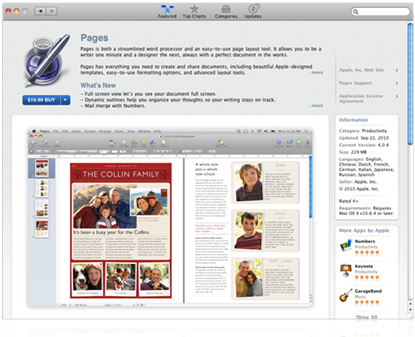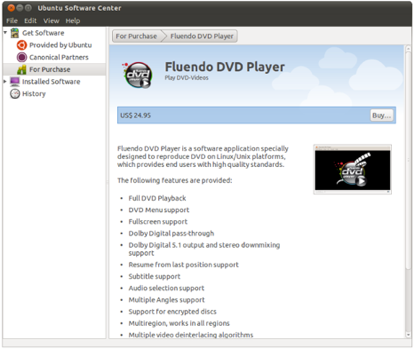Lion
In a special event a few days ago, Apple has shown some features planned for the next version of Mac OS X. Mac OS X is absorbing a bunch of ideas from iOS: An App Store of its own, a version of Springboard, and full-screen apps.
The Mac App Store
The App Store on the iPhone is bordering on useless for discovering content. I mostly discover new apps outside of the App Store--friends show me apps on their phones, or I read about them on the web. Almost every time I've tried to find new apps by browsing the App Store, I have failed. For example, try searching for apps that help you keep track of your running. How many useless apps do you have to wade through until you find, say, the excellent Kinetic? Try searching for a Wikipedia client. Where's Articles?
It is an unfortunate fact that even "Pirate App Stores" for jailbroken iPhones provide a better user experience than the official iPhone App Store, simply because people don't want to pirate crappy apps, and thus don't clutter up their stores with them.1 Apple is doing such a poor job keeping the bad apps out of their store that even software pirates are doing it better. That's not good. You fight piracy by providing a better experience, not by providing a worse experience and asking people to pay for it.
Why are there so many bad apps in the iPhone App Store?
I suspect that one of the reasons for this is that Apple can't easily reject apps, since the App Store is the only way of selling iPhone apps. If you're rejected by Apple, all of the work you've put into your iPhone app is now worthless. So Apple is understandably reluctant when it comes to rejecting iPhone apps.
Additionally, Apple is in active competition for the biggest App Store. The fact that the iPhone has many more apps in its store than, say, Android, is touted as an advantage for the platform. That many of the apps in the App Store only serve to confuse iPhone users and hide the truly good apps under a flood of shovelware is, of course, ignored in that argument.
Neither of these two points apply to the Mac. Rejected apps can still be sold outside of the App Store, so there's less pressure to accept crappy apps. And there's no real competition for the Mac App Store, so there's less of a marketing reason for accepting as many apps as possible.
As a result, I hope that the Mac App Store will serve as a showcase for the best Mac apps, rather than as a horrible mess of as many apps Apple can accept in the shortest time possible.
Installing Apps
I've previously said that installing apps on the Mac is broken. Apple is finally starting to fix this with the Mac App Store:

The App Store is long overdue, and finally brings the user experience for installing and updating apps up to par with Ubuntu:
Unfortunately, this improved user experience only seems to apply to apps sold in the App Store. It would have been great if Apple had solved this problem for everybody, rather than just for the developers who agree to give 30% of their revenue to Apple, and who will be accepted into the store. Mac developer Jonathan 'Wolf' Rentzsch writes:
Apple, a corporation with billions and billions of dollars in the bank, is taking 30% of small Mac developer’s revenue — an outrageously high fee, more than three times what popular high-end fulfillment provider FastSpring charges.
(Macworld and Ars Technica also have developer reactions to the Mac App Store announcement.)
Presumably, a lot of apps won't be available in the Mac App Store. Apple should provide a better way of handling application installs, updates, and removals for those apps, as well.
But now Apple has the incentive to tie improvements to the Mac App Store, to encourage developers to give it a cut.
As an aside, something that's lacking from all of Apple's App Stores is the ability to buy things other than apps. Fonts, Dashboard widgets, and plug-ins would all be welcome. Especially on the iPad, the fact that people can't easily get additional fonts makes the device much less useful.
Overlapping Windows
Apple has added "systemwide support for full-screen apps" to Lion. While I agree that the window management system we currently have often causes huge usability issues,2 simply doing away with it altogether is not solving the problem. It's capitulating.
There has got to be a way of managing windows that gets rid of the problems caused by overlapping windows, while still giving people the ability to see more than one app at a time. How often do people write text while referring to a webpage? How often do people drag a picture from iPhoto into a Word document, or a file from a Finder window into an email message? Even the most basic tasks commonly require people to see more than one app at a time.
Usability, discoverability, and efficiency are a balancing act that is audience-dependent. I think we should be focusing more of our "make it simpler to use, make it easier to learn" energy on iOS and our "make it more flexible, make it more powerful" energy on Mac OS. Because iOS is the future of casual computing.
While I don't mind making the Mac easier to use and learn, I feel that simply switching to full-screen modes isn't a good way of doing that.
The Finder: Just Another App
By now, it seems obvious that Apple isn't interested in rethinking the Finder. Instead, the goal seems to be to de-emphasize it. Thus, Launchpad, a home screen for the Mac. I suspect that Apple wants people to use Launchpad as their default way of accessing their Macs, rather than the Finder. I further suspect that Apple would like it if applications took over management of their own files, similar to how iPad apps do this.
I would have preferred to see an actual solution to the problem of file management, but I guess de-emphasizing the Finder is at least a step in the right direction. Maybe a solution is still in Mac OS X's future. Steven Troughton-Smith writes:
This signifies, at least to me, a move away from the files and folders model of interaction with computers. As with iOS, the location the applications are stored in becomes an implementation detail. In the very near future, we may not even need a Finder app to browse our hard disk; folders just become metadata, and everything lives in a global 'soup' (Apple Newton users will be familiar with this idea).
We'll see.
Java
Looks like Apple isn't sure whether it'll ship Java with Lion:
Developers should not rely on the Apple-supplied Java runtime being present in future versions of Mac OS X.
While there are some user-level OS X games and apps that use Java, this is going to be a bigger issue for developers. Many IDEs (at least the ones not from Apple or Microsoft) use Java.3 Without support for Java, developers of mobile apps won't be able to use OS X to develop both for the iPhone and for Android. Fortunately, there are alternatives, and by the time Apple actually kills Java, they'll hopefully be mature enough to simply replace Apple's Java.4
At least this allows Apple's Java developers to work on other things. Matt Drance writes:
Every hour of talent spent on Java is an hour not spent on the next Core Animation; the next Mission Control; the next iPhone.
Maybe now we won't have to wait quite so long for the next major release of Mac OS X?
-
I'm proud to say that my own iPhone game made the cut and is available in at least some pirate stores, though. ↩︎
-
I use Divvy to manage windows on my Mac. It solves some of the problems caused by overlapping windows. If you're interested in alternative ways of managing windows on Macs, you should probably also check out Cinch and SizeUp by Irradiated Software. ↩︎
-
Eclipse and IntelliJ IDEA, for example. ↩︎
If you require a short url to link to this article, please use http://ignco.de/334





